Airline Pilot Named A Hero For Saving Passengers From Deadly Snake
While flying a plane, a pilot felt something cold slither across his back, and to his surprise, it was a Cape Cobra, an extremely deadly snake; following the discovery he turned the plane around and got all passengers to safety.
This article is more than 2 years old

When South African pilot Rudolf Erasmus took off from Worcester in the Western Cape province last Monday, he thought his light jet was carrying four passengers. He soon discovered that there were actually five living beings sharing his airspace, the last one a reptile. But it wasn’t just any reptilian, it was a Cape Cobra—a particularly deadly snake species in South Africa.
The deadly snake made itself known when it slid across Erasmus’ lower back. “I felt this little cold sensation underneath my shirt where my hip is situated — but basically where you’ve got your little love handles,” he told NPR. He glanced down to see the head of the large Cape Cobra slipping back under his seat.
“It was as if my brain didn’t know what was going on,” Erasmus told The Associated Press. He took a moment to compose himself before telling his passengers about the sneaky stowaway. “There was a moment of stunned silence,” he said, noting that everyone remained surprisingly calm.
“I kept looking down to see where it was. It was happy under the seat,” Erasmus said. “I don’t have a big fear of snakes but I normally don’t go near them.”
The private flight had been slated to land in Nelspruit, about 1,000 miles northeast of Worcester. However, when Erasmus discovered the deadly snake, he called air traffic control for permission to make an emergency landing at the nearest airport. He had to fly for an additional 10 to 15 minutes with the snake at his feet before landing in the town of Welkom.
Aviation expert Brian Emmenis, who also works at Welkom radio station Gold FM, was called to ask if he could help. Emmenis called the local fire and rescue department and they sent first responders—and a deadly snake handler—to meet the plane at the airport. Emmenis was the first person to see Erasmus and his passengers disembark and told AP that they were “visibly shaken” but safe.
“He stayed calm and landed that aircraft with a deadly venomous Cape Cobra curled up underneath his seat,” Emmenis said. He praised Erasmus for his quick thinking and bravery that kept everyone safe. The pilot said that his primary thoughts were keeping his passengers safe from the deadly snake.
“I was more afraid of what the snake might do. Luckily it didn’t strike anyone, otherwise, that would have changed or complicated the whole situation,” Erasmus said. South African civil aviation commissioner Poppy Khoza called Erasmus a hero and credited him for saving all the lives on board.
The Cape Cobra is also called the yellow cobra and inhabits a wide variety of biomes across South Africa, Botswana, Lesotho, and Namibia. It can grow up to 1.4 meters long and its venom can kill a human within one hour. According to Animalia, Cape Cobras are generally calm compared to other deadly snake species in Africa but will strike unhesitatingly if threatened.
Unfortunately, the deadly snake was not finished causing mischief for the pilot and snake handler Johan de Klerk after the plane landed. Despite having help from a team of aviation engineers, neither man could find the Cape Cobra after two days of searching. By Wednesday, they were speculating that the snake had somehow disembarked undetected.
Because the engineering company that owns the plane needed it back, Erasmus had to fly it another 90 minutes not knowing whether the deadly snake was still aboard. To be safe, the pilot wore a thick winter jacket and wrapped a blanket around his seat. He also equipped the cockpit with a fire extinguisher, a can of insect repellant, and a golf club, all within arm’s reach.
The Cape Cobra did not reappear on that flight, nor after the plane was completely stripped and inspected. It’s assumed that the deadly snake slipped off as easily as it slipped onto the plane. Or perhaps, it might still be hiding somewhere deep inside the aircraft.




